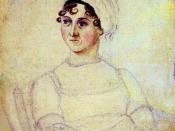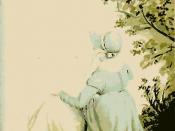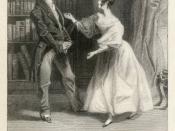The novel Pride and Prejudice, by Jane Austen, covers a number of moral and social aspects that not only pertain to nineteenth century Great Britain, but to humanity as a whole. Pride and prejudice, which are both part of the novel's title, are explored extensively through two of the main characters. The novel's story is essentially a romantic tale of how two individuals overcome obstacles placed before them by society, other people, and themselves, to end up in a happy marriage. Throughout the book, Elizabeth Bennet, the female protagonist, overcomes her prejudice against Fitzwilliam Darcy, who makes a bad first impression on her. Darcy, in turn, has to overcome his proud nature, which comes from his high birth and affluence, in order to win over Elizabeth and realize what love really is. The progression and changes in Darcy's pride and Elizabeth's prejudice are two of the focal points of the story whose developments can be traced throughout the novel.
Elizabeth and Darcy's first encounter is at a ball, and Darcy's comments and behavior there set Elizabeth's prejudice against him. At first Darcy is admired by the townsfolk, but soon they find him "to be proud, to be above his company, and above being pleased" (6). Then Elizabeth overhears Darcy telling his friend that he will not dance, and that Elizabeth herself is only "tolerable; but not handsome to tempt [him]" (7). This remark sets her prejudice against Darcy, whom she scarcely knows, and follows her through part of the novel. Darcy's pride can be attributed to his upbringing, as he himself later tells Elizabeth that he was "given good principles, but left to follow them with pride and conceit" and was "spoilt by [his] parents, who... allowed, encouraged, almost taught [him] to be selfish and overbearing" (282). His...


